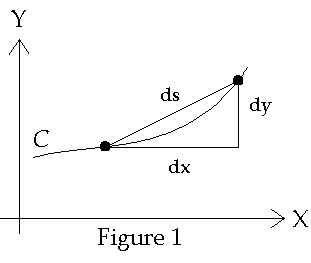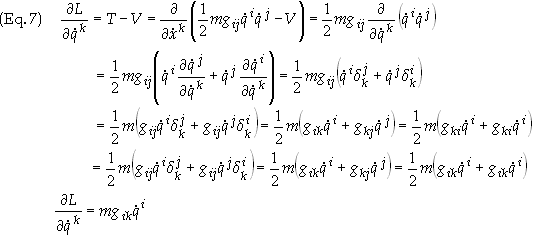
Geometric
Equation of Motion
Back
to Physics World
Back to Classical Mechanics
The
equation of motion can be derived from Lagrangeís equations. When expressed in
geometric terms using the metric tensor the classical equation of motion for
zero force motion has the form of the geodesic equation.
In Euclidean geometry the infinitesimal distance, ds, between two
closely spaced points is shown in Fig. 1 below

given in
terms of the metric tensor for flat space hij
= diag(1,
1, 1) as
![]()
Einsteinís
convention is employed here; when an index appears twice in a term, once as a
superscript and once as a subscript, the summation is implied over the valid
range of the index, in this case the range is from 1 to 3. The metric tensor
satisfies the following relations

From
herein we will use generalized coordinates qi
in which the components of the metric tenors will be labeled as gij.
Dividing Eq. (1) through by dt2 gives
the square of the velocity, i.e.
![]()
The
kinetic energy, T, is then given by
![]()
The
Lagrangian is then given by
![]()
It is
here assumed that V is only a function of position, and not velocity
dependant, and therefore does not depend on time explicitly. The equations of
motion may be obtained through the use of Lagrangeís equations

The
first step to finding the equation of motion is to calculate the following
quantity, noting that the components of the metric tensor are not functions of
the velocity

The next
step is to take the derivative of this result with respect to time

The next
step is to find the right hand side of Eq. (6) by taking the partial derivative
of Eq. (5)

Equating
Eq. (9) with Eq. (10) we obtain
![]()
This
result can be simplified with some index gymnastics, i.e. note that the second
term on the left hand side can be rewritten as
![]()
Substituting
into Eq. (10) gives upon rearrangement of terms
![]()
Multiply
through by gnk
to get

Eq. (13)
may also be simplified considerably. Recall the definition of the Christoffel
symbols
![]()
The
covariant components, Fk,
of the force are defined as
![]()
The
contravariant, Fk,
components of the force are defined as
![]()
Eq. (13)
may now be expressed in a simplified form as

This too
may be simplified by employing the absolute derivative of the components
of a vector which are defined as
![]()
![]()